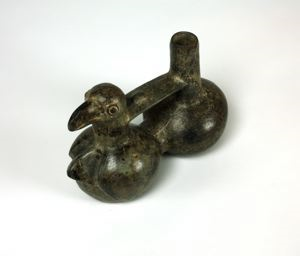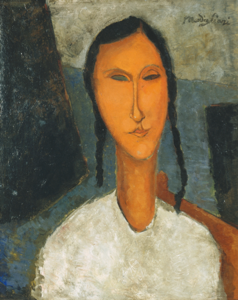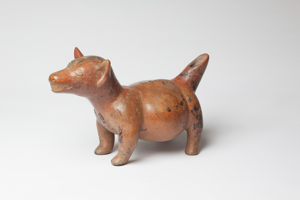FILTER RESULTS
Whistling Jar with Bird Head
1000 - 1466 CE11th-15th century
6 1/4 in. x 3 5/8 in. x 8 1/8 in. (15.88 cm x 9.21 cm x 20.64 cm)
Chimú, Peruvian, (1000–1466)
Object Type:
Pre-Columbian
Medium and Support:
Blackware
Credit Line:
Gift of William O. Gross Jr.
Accession Number:
1986.084
Object Description
Double bodied whistling jar with one side a handsome stylized curved beak bird; dark grey mottled; root marks overall. These types of bottles typically were found on the North coast of Peru. This bottle was likely a result of the Inca taking items and bringing them back from other ethnic groups they conquered in an effort to expand their empire. According to Steven Garrett, ceramic whistling bottles were mass-produced on the north and central coasts of Peru and highlands for 2000 years starting in 500 B.C. He explains that whistling bottles were regarded as utilitarian containers with the whistle providing a vent to accelerate the passage of air when pouring and filling with liquid. It has been suggested that these bottles were used as whistles, potentially in a ritual context (Garret and Stat 1977:23).
The vessel’s structure is complex. There are two bodies, two necks, the bridge handle, the whistle chamber and the whistle cavity (Figure 3). Donnan explains that Andeans first created whistles and whistling mechanisms, but then figured out how to incorporate them into bottle forms. Regarding the whistle he says, “Most often [the whistle] was built inside the sculptural shape on top of the bottle chamber. When one blew into the spout, the air passed through the chamber and into a tube that was part of the whistling mechanism. This tube then directed the air across the opening of the sphere, creating a whistling sound” (Donnan 1992:30). Donnan also discusses double-chambered whistling bottles saying that potters also made what is known as a double-chambered whistling bottle. Double-chambered whistling bottles consisted of two chambers connected to one another by a hollow passageway between their chambers (Donnan 1992:30). Whistling bottles work in two ways: they can either produce sound on their own or a person can manually blow air through the spout of the bottle and produce sound. The two bodies of the vessel are filled with water depending on what kind of sound the user wants to produce. Lower levels produce high pitch sounds while higher levels of water produce lower pitch sounds (Garret and Stat 1977). Typically, the bodies are filled approximately half full with liquid because if they are too full the bottle will not make any sound; space must be left for air in the bodies. One way to produce sound is to tilt the bottle so that the majority of the liquid passes out of the body where the whistle is located and into the other body. Then the bottle must be tilted in the other direction so that the water flows back into the body where the whistle is. This displaces the air in that body and forces it out through the tube of the whistle chamber. Thus, the bottle can produce a whistling sound every time it is tilted back in forth. The other way it can produce sound is if the user puts his or her mouth on the everted lip spout and blows air through the bottle. The air will still be displaced and the air will come out of the whistling chamber producing a whistling noise (Donnan 1992:32).
The bird on the top of the spout can be viewed as a tribute to the gods. According to Makowski, this bird could be interpreted as representing two historical Inca symbols:
1) First, the bird could be a depiction of the Inca bird, Indi. During the Late Intermediate Period, Mayta Capac, the fourth Inca ruler in his destiny, was in power. Mayta Capac had superhuman strength and his strength led to his being associated with the Thunder and Lightning god. According to this myth, Mayta Capac distinguished himself as a military leader after the time of Manco Capac. In particular, Mayta Capac opened the box or hamper with the idol of Manco that was a bird called Indi [or Inti] (Steele 2004). Maya Capac’s predecessors had always feared opening the box of Manco, but Mayta did so, and spoke to the Indi. Myths say that the bird gave Mayta oracles and wisdom that he did not have. Paul Steele (2004) suggests that the opening of the box was a sign of the Incas’ willingness to fight, specifically against the Alcavizas. thus, the bird atop the bottle could symbolize the change of strategy of the Inca during the Alcaviza feud, from a more laissez-faire attitude to a more antagonistic one. The Inca were able to combat these conflicts, however, so the bird could also represent the empire’s victory.
2) Another possible interpretation of the bird is a condor. According to Steele (2004), the condor is one of the most important decorations because of its mythological meaning. The condor was viewed as a sacred animal, and so the Incas built the sacred Temple of the Condor in Machu Picchu. The condor was said to grant the status of Andean King and can be seen from any location of Machu Picchu. In the Inca civilization, the condor was a holy representation of both production and fertility because the contemporary accounts tell that when the condor, to move their wings, gathers clouds that would produce rain, the best fertilizer for the land (Steele 2004). Max Uhle explains that various provided the Incas a complete mythological explanation for the sun and constellations. The bird on the bottle, and other sacred animals in general, were more than symbols, they held religious meaning and served as explanations for events and traditions in the Inca Empire (Steele 2004). All in all, the symbols that this whistling bottle depicts have deep-rooted meanings, whether they were used as a sign of worship to the gods or if they were images that represented prayers and wishes of the Inca people for themselves and their society.
Keywords
Click a term to view the records with the same keyword
This object has the following keywords:
Additional Images
Click an image to view a larger version
Exhibition List
This object was included in the following exhibitions:
- Ancient Americas in a New Light , 2/26/2022 - 8/20/2022
Portfolio List
Click a portfolio name to view all the objects in that portfolio
This object is a member of the following portfolios:



